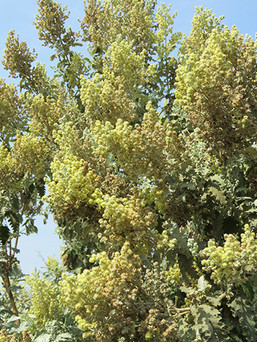Start your Garden with easy-to-grow, water-wise Shrubs
- Anno Torr
- Apr 22
- 5 min read
Updated: May 18
Spring is the optimal time to establish plants in the summer rainfall regions; we’re a month in, so let’s get cracking.
We’ll begin with shrubs that embody a trifecta of valuable traits suitable for current gardening conditions: easy-to-grow, low-maintenance and water wise. They are perfect choices to help establish new gardens, change form exotic to indigenous, or anywhere you need rapid establishment, quick soil cover, a privacy screen, wind barrier, and quick flowering.
But, first things first; for optimal growth and to reduce the chances of frustrating failure, you must match plant to place, and plant to purpose. We’ve already uploaded an article to get you started: How to assess and manage your garden’s microclimates. Even seasoned gardeners can benefit from a re-read. Included in that article is a checklist of things to take note of which you can download as a separate sheet to print out and fill in as you work through your various sections of the garden.
With your assessment done, list what purpose you want the shrubs to perform.
Privacy screen: How high does it need to be? If for a small enclosure do you want a metre high barrier or higher? Do you need a tall, evergreen shrub to block a neighbour or an unsightly view, or a dense, 5 m screen to hide a road? Can you combine tall species to block up high and smaller shrubs to plump out the ground-level screen?
Windscreen: How strong is the prevailing wind? This governs plant choice; strong winds require a mix of shrub sizes, flexible branches and small leaves.
Other possible uses:
Cover an unsightly wall or soften reflective glare off a hot, pale-coloured wall. You may prefer a shrub to a creeper that would require wall support. Does it need to be tall but narrow?
Demarcate a boundary – where fences are not used as in many small estates, or to mark out a small enclosure.
As a low wall around a food garden: choose fragrant species and those that attract pollinators and predators.
Shrubs to screen the swimming pool; keep away from thorny species that can injure cavorting kids.
Wildlife shrubbery; combine this with a privacy screen and include plants with fruits, tangled stems for nesting platforms, foliage to host caterpillars. Mix species to ensure leaf cover from the ground up, and a select range to ensure flowers and fruits through the year.
A security barrier; choose multi-stemmed shrubs with thorns and a strong skeleton.
To ensure your shrubs need as little interference as possible planting distance is important:
Fitting a shrubs final size to the available space saves frequent pruning to keep it in bounds.
Generally, shrubs will thrive if given enough room to fill out without competing for space and nutrients.
However, for security screens and hedges, you can place plants closer together for rapid knitting.
For a wildlife shrubbery a variety of animals enjoy continuous cover for safe foraging, so let plant edges overlap slightly. Mix and match size and shape, and your wildlife shrubbery will fit together like a well-designed puzzle.
Blanket the ground between shrubs with a thick 3 to 5 cm organic mulch layer, but not touching the stem. Top up as soil organisms’ work this natural food into the soil. If rains are plentiful and consistent, you probably won’t need to water the plants after the initial bucket full, but keep watch; if there are too many hot, windy days and only light rainfall, respect your areas water restrictions and give them buckets of grey water from the house. This way, you also know just how much they’re getting.
Species list
Our selection is a mix of pioneer and longer-lasting plants. Pioneer species are Nature’s spirited adventurers who pave the way by colonising an area to create suitable conditions for the rest to follow. They are tough plants whose role in nature is to begin the growth process in disturbed areas, grow rapidly, regenerate the soil and provide quick habitat in which other species can successfully germinate, before dying off. Their roots help to break up the soils enabling other plants to establish; through leaf drop, they add humus to the soil, and they protect the ground from further compaction, drying out and erosion. They often offer a variety of food sources that bring in a wide variety of pollinators which helps to spread the seed of other species. Because of their rapid growth and ability to grow easily in any soil with minimal care, pioneer plants are very successful plants with which to start your indigenous garden as are all fast-growing, easy-care shrubs on this list.
To make your choice easier, we’ll add this category to the Plant Library shortly, arranged according to region and light conditions.
Aloe arborescens 2 x 3 orange, peach
Aloe tenuior 1.5 x 1.5 yellow, orange-red
Anisodontea julii 2 x 1 pink
Athanasia dentata 1 – 1.5 m yellow
Barleria albostellata 1.5 x 1.5 white
Barleria obtusa 1 x 1 blue
Barleria prionitis 0.4-1.5 m yellow
Bauhinia galpinii 3 x 5 m brick red
Bauhinia natalensis 2.5 x 3 m white
Buddleja auriculata 4 x 4 cream
Buddleja glomerata 4 x 3 m cream
Buddleja salvifolia 5 x 4 m lilac, cream
Buddleja loricata 3 – 4 m cream
Crotalaria capensis 3 x 3 yellow
Croton pseudopulchellus 2 x 3 cream
Dodonaea viscosa 4 x 4 yellowish green
Dombeya burgessiae 4 x 4 pink, white
Duvernoia adhatodoides 3.5 x 3 m white-cream shade
Dyschoriste thunbergiiflora 1.5 x 1.5 purple
Ehretia ridiga 4 x 4 white-mauve
Euryops pectinatus 1 x 1 m yellow
Euryops tysonii 1.5 x 1.5 m yellow
Grewia lasiocarpa 3 - 5 m high pink
Grewia occidentalis 5 x 3 m mauve
Halleria lucida 6 x 5 m orange, red
Helichrysum splendidum 1.5 x 1.5 m yellow
Hymenolepis crithmifolia 2.5 x 2 m yellow N/ Western Cape
Hypericum revolutum 3 x 3 yellow
Hypoestes aristata 1.5 x 1 mauve
Indigofera frutescens 3 x 2 pink
Leonotis leonurus 2 x 1.5 m orange, white
Lippia javanica 2 x 2 m white-green
Mackaya bella 3 x 2 white shade
Maesa lanceolata 3 x 4 white-cream
Matalasia muricata 3 x 3 white, pink
Metarungia longistrobus 1.5 x 1 peach
Ocimum labiatum 1.5 x 1.5 m pink
Osteospermum moniliferum 2 x 5 yellow
Pavonia praemorsa 1.2 x 1.2 m yellow
Pelargonium cordifolium 1 x 1 pink
Pelargonium cucullatum 1 x 1 pink
Pelargonium graveolens 1.3 x 1 m pink
Plectranthus ecklonii 1.5 x 1.5 purple, white, pink
Plectranthus fruticosus 1 x 1 pink, purple
Plectranthus zuluensis 1.7 x 1.5 purple, blue, white
Plectranthus hadiensis 1.5 x 1 m white, mauve
Plectranthus saccatus 80 x 80 cm blue, white
Plumbago auriculata 3 – 5 x 3 m blue, white
Podalyria calyptrata 2 – 3 m pink
Podalyria sericea 1 x 1 m pink
Polygala myrtifolia 2.5 x 2.5 m purple
Pycnostachys urticifolia 1.2 – 1.5 x 1.5 m blue
Rhamnus prinoides 4 x 4 m green-cream
Salvia africana- caerulea 1-1.7 m x 1 m blue
Salvia africana- lutea 1.5 x 1.5 brown-peach
Searsia crenata 4 x 4 m yellow
Sparmannia africana 3 x 4 m white
Sutherlandia frutescens 1.25 x 1 m scarlet
Syncolostemon obermeyerae up to 1.8 m tall pink-mauve
Syncolostemon transvaalensis 0.7 - 1 m pink-mauve
Tarchonanthus camphoratus 5 x 5 m cream
Tarenna pavettoides 4 x 4 white for damp shade
Tecomaria capensis 2 – 3 x variable various colours
Thorncroftia longiflora 1m x .50 m mauve
Thorncroftia succulenta 1 x .50 m mauve











































Comments